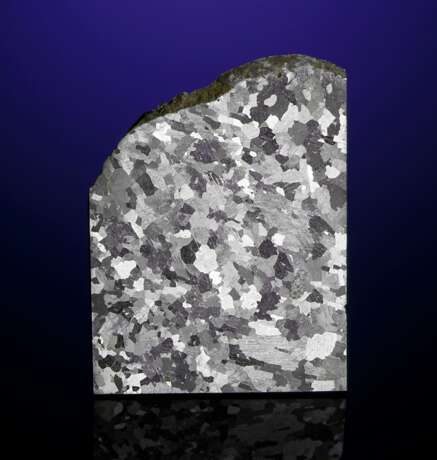ID 491232
Lot 22 | WILLAMETTE METEORITE — A PARTIAL SLICE OF THE MOST FAMOUS METEORITE IN THE WORLD
Valeur estimée
$ 6 000 – 9 000
In 1999, a coalition of Oregonian Native Americans, The Confederated Tribes of Grand Ronde, filed a claim to have the meteorite returned to Oregon by invoking the Native American Graves Protection and Repatriation Act (NAGPRA). According to Clackamas tradition, the meteorite, called “Tomanowos”, was delivered from the Moon to the Clackamas at the beginning of time. The Museum went to federal court seeking a declaratory judgment against the Grand Ronde, and as part of a settlement, it was decided the meteorite would remain a Museum centerpiece and never again be cut. However, it’s as a result of it having been cut that UCLA researchers recently demonstrated that Willamette is the sole known representative of its parent asteroid and is a member of the rare “ungrouped” class of iron meteorites.
With one edge of the meteorite’s natural exterior, Willamette’s signature recrystallized Widmanstätten pattern is showcased to marvelous effect. Spanning the uppermost edge is the meteorite’s exterior surface. It’s virtually unheard of to be able to obtain a sample of a centerpiece exhibit at a world-renowned museum — this is one such exception. Modern cutting.
Christie's would like to thank Dr. Alan E. Rubin at the Department of Earth, Planetary, and Space Sciences, University of California, Los Angeles for his assistance in preparing this catalogue.
57 x 45 x 2mm (2.25 x 1.75 x 0.1 inches) and 47.2 grams
| Adresse de l'enchère |
CHRISTIE'S 20 Rockefeller Plaza 10020 New York Etats-Unis | ||||||||||||||
|---|---|---|---|---|---|---|---|---|---|---|---|---|---|---|---|
| Aperçu |
| ||||||||||||||
| Téléphone | +1 212 636 2000 | ||||||||||||||
| Fax | +1 212 636 4930 | ||||||||||||||
| Conditions d'utilisation | Conditions d'utilisation | ||||||||||||||
| transport |
Service postal Service de messagerie ramassage par vous-même | ||||||||||||||
| Modes de paiement |
Virement bancaire | ||||||||||||||
| Heures d'ouverture | Heures d'ouverture
|



